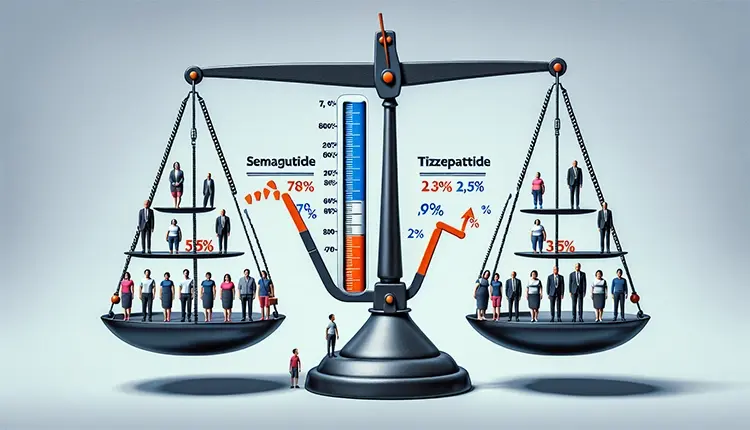Key Takeaways
- Tirzepatide targets both GLP-1 and GIP receptors, leading to enhanced weight loss through appetite suppression, increased energy expenditure, and reduction in fat mass, whereas Semaglutide works mainly by reducing energy intake.
- Clinical trials, particularly the SURMOUNT series, have demonstrated that tirzepatide achieves greater and more sustained weight loss compared to semaglutide, with a higher percentage of patients reaching significant weight loss milestones.
- Both medications improve glycemic control and cardiovascular outcomes, although tirzepatide has shown superior efficacy in reducing HbA1c levels and supporting long-term weight management, despite potential gastrointestinal side effects and high costs associated with treatment.
Wondering whether tirzepatide vs semaglutide weight loss is the better option? In this article, we’ll compare these medications, exploring their mechanisms, clinical trial outcomes, side effects, and long-term results. Discover which one could be more effective in helping you achieve your weight goals.
Mechanisms Behind Weight Loss

Understanding the underlying mechanisms that drive weight reduction is a fundamental part of obesity management. Tirzepatide, wielding dual receptors’ power, targets not only GLP-1 but also GIP, paving the way for a two-pronged attack against excess body weight. This innovative drug does more than just suppress appetite; it enhances energy expenditure and orchestrates fat mass reduction, making every calorie count. Semaglutide, while also a GLP-1 receptor agonist, focuses on reducing energy intake, but without the added effect of glucose dependent insulinotropic polypeptide (GIP) receptor.
The science of weight loss with these drugs is akin to a finely tuned orchestra. Both medications conduct a symphony of satiety, leading to significant reductions in energy intake during meals. However, tirzepatide’s additional role in managing adipose lipid storage gives it a unique edge, allowing for greater weight loss by fine-tuning the body’s energy balance.
Preventing weight regain is a vital component in the concert of weight management. While both drugs play their parts in reducing body weight, tirzepatide’s dual-action mechanism may offer a more harmonious solution for maintaining long-term weight control. As we move forward in our exploration, we’ll delve into the compelling evidence from clinical trials.
Clinical Trials Comparing Weight Loss
The SURMOUNT trials, a robust series of comparative studies, serve as the stage for understanding the efficacy of tirzepatide versus semaglutide in weight management. These trials harmonized the melody of weight reduction with lifestyle counseling, ensuring participants danced to the tune of a healthier beat. As doses of tirzepatide crescendoed every four weeks, so too did the potential for weight control.
In the audience of these trials were adults, some with the added challenge of type 2 diabetes, all sharing a common desire for weight reduction. The SURMOUNT-1 trial focused on those without diabetes, while SURMOUNT-2 cast a spotlight on those with the condition, comparing the impact of tirzepatide against an invisible adversary: placebo. Both trials measured the change in body weight as their primary endpoint, a critical note in the composition of diabetes control.
As with any grand performance, not all were invited to partake. Key exclusion criteria ensured the safety and relevance of the trials’ outcomes, fine-tuning the demographic to a fitting ensemble. The careful selection of doses and the methodical ramp-up of tirzepatide and semaglutide ensured that each participant received the proper treatment intensity for their solo.
Randomization added a layer of impartiality to the randomized controlled trials, assigning participants to either the tirzepatide or semaglutide groups in equal measure, ensuring a fair comparison of these two agents in the spotlight of clinical scrutiny. Now that we’ve set the context with these trials, let’s investigate the effectiveness of each medication in orchestrating weight loss.
Efficacy in Reducing Body Weight

As the results of the SURMOUNT trials echoed through the halls of medical research, it became clear that tirzepatide was the maestro of weight reduction. Patients under its guidance experienced a greater diminuendo in body weight compared to semaglutide, hitting more significant weight loss milestones with larger percentage losses at various intervals.
The success of tirzepatide was not just in minor weight shifts but in substantial body weight reductions that resonated with patients’ goals. The data crescendoed with more than half of the tirzepatide group achieving at least a 15% weight loss within one year, a feat less commonly seen with semaglutide.
Quantifying this success, the hazard ratios for reaching weight loss thresholds were notably higher with tirzepatide, creating a symphony of success stories that rang louder and clearer than those of semaglutide. Moreover, the scales tipped further in favor of tirzepatide, with average reductions in body weight outperforming semaglutide by up to 5.5 kg, striking a powerful chord in the weight management repertoire.
With each pound shed, tirzepatide reaffirmed its efficacy in reducing body weight, offering a promising encore for those seeking to manage their weight. Yet, as we pivot from the efficacy of weight loss to the harmony of blood sugar levels, another aspect of these medications emerges – their impact on glycemic control.
Impact on Glycemic Control
The melody of weight management often intertwines with the rhythm of blood sugar control, and in this duet, tirzepatide has shown it can lead with confidence. The SURMOUNT trials set out to measure the change in HbA1c levels, a critical marker for glycemic control, and found that tirzepatide conducted larger reductions than semaglutide.
These improvements in HbA1c were not just marginal; they were striking, particularly in patients who started with higher baseline levels. Tirzepatide’s performance reached a crescendo in those with the most significant need, reducing HbA1c by over 3 percentage points in patients whose baseline levels were above 8.5%.
The overall score of the trials revealed tirzepatide’s superior ability to improve glycemic control, with reductions in HbA1c levels that consistently outperformed semaglutide across various doses. Moving our focus from blood sugar control to side effects, we must remember that even the most effective treatments need to strike a balance between efficacy and safety.
Side Effects and Safety Considerations
Despite the therapeutic benefits of tirzepatide and semaglutide, we can’t ignore the potential side effects. The most prevalent among these are gastrointestinal events, which, though typically mild to moderate, can disrupt the rhythm of treatment.
The frequency of such gastrointestinal adverse events varied across the SURPASS trials, with up to half of the participants experiencing some form of gastrointestinal discomfort. Yet, the rate of individuals choosing to discontinue treatment due to these serious adverse events remained relatively low, suggesting most patients find a way to harmonize their regimen with their daily lives, even when taking higher doses.
Real-world data from Truveta mirrored the clinical trial chorus, showing a similar safety profile for both medications, which speaks to the manageable nature of these adverse events. As the narrative unfolds, the long-term weight management benefits of tirzepatide and semaglutide come into focus, offering insight into their sustained impact beyond the initial period of weight loss.
Long-Term Weight Management

Starting a weight loss journey with tirzepatide or semaglutide is akin to embarking on a lengthy voyage. Here, maintaining the results is just as critical as the initial success. Tirzepatide, especially, has demonstrated its ability to sustain its weight loss benefits, with most participants maintaining their initial weight reduction even after 88 weeks—a remarkable feat in the world of weight management.
However, discontinuing tirzepatide can be likened to abandoning the ship mid-journey, resulting in a significant weight regain. This stark contrast underscores the importance of ongoing therapy in preserving the hard-earned results of weight loss.
For those who continued their tirzepatide treatment, the additional weight reduction achieved during a year-long extension period was a testament to the drug’s ability to not only reach but also extend weight management goals. With the ebb and flow of weight management in mind, the financial tide of drug costs and accessibility comes into play, influencing the reach of tirzepatide and semaglutide’s benefits.
Cost and Accessibility
The quest for weight loss can be an expensive endeavor, and the cost of tirzepatide and semaglutide is no exception. Despite the differences in Medicare Part D coverage for these medications, the out-of-pocket costs can be a significant burden for many, estimated to exceed $2000 annually.
Medicare’s intricate coverage landscape, with its tier levels and authorization requirements, creates a maze for those seeking access to these GLP-1 receptor agonists. However, the Inflation Reduction Act offers a beacon of hope, capping Medicare out-of-pocket drug costs and potentially easing the financial strain for many.
Patient assistance programs also play a role in navigating the costs associated with these medications. Although details were not provided, the existence of such programs can be a lifeline for those who would otherwise be unable to afford these life-changing treatments.
Beyond the financial aspects of tirzepatide and semaglutide, understanding the factors that determine a patient’s suitability for either drug is also significant.
Patient Suitability
The journey to weight loss is deeply personal, and the suitability of tirzepatide or semaglutide for an individual can depend on a myriad of factors. Patients with a history of gastrointestinal issues may lean towards semaglutide, given its established track record and the accumulated knowledge on managing its side effects.
The method of administration and the side effect profile play a significant role in a patient’s willingness to continue treatment. A medication’s ease of use and tolerability are key notes in the symphony of patient preference, influencing the likelihood of a successful and sustained weight loss journey. In this context, managing weight becomes an essential aspect to consider.
It’s worth noting that Medicare’s restrictions on covering obesity-specific medications may also affect patient access to these treatments. This policy may limit the options available to those seeking support in their weight management efforts.
Taking these considerations into account, let’s shift our focus to the impact of these medications on established cardiovascular disease outcomes, a primary concern for many patients.
Cardiovascular Outcomes
The intersection of weight loss and cardiovascular health is a critical crossroads for patients with type 2 diabetes and obesity. Semaglutide has taken a significant step forward, showcasing a reduction in major adverse cardiovascular events, which marks a triumph in the quest for better cardiovascular outcomes.
Both of these compounds contribute to cardiovascular wellness by improving blood pressure and lipid profiles, further solidifying their role in comprehensive health management. However, the cessation of tirzepatide treatment serves as a cautionary tale, with the potential reversal of these benefits emphasizing the importance of continued therapy.
The safety of these medications is underscored by the low incidence of cardiovascular-related deaths during the trials, offering reassurance to both patients and healthcare professionals that these treatments can be part of a heart-healthy regimen. Reflecting on these clinical settings prompts us to consider the performance of tirzepatide and semaglutide in the more unpredictable real-world scenarios.
Comparisons in Real-World Settings
The true measure of a medication’s effectiveness is often found not in the controlled environment of clinical trials but in the diverse tapestry of real-world practice. Tirzepatide has shown to be a formidable contender in this arena, with up to three times more effectiveness in weight loss compared to semaglutide.
A study by Truveta involving a significant sample of over 40,000 patients provided a broad canvas to assess the comparative effectiveness of these medications. The results highlighted tirzepatide’s superior ability to help patients achieve various levels of weight loss, further supporting its role in real-world obesity management.
The study also revealed that the relative effectiveness between tirzepatide and semaglutide remained consistent, regardless of diabetes status, offering a beacon of hope for a broad range of patient populations seeking weight control solutions. With this real-world evidence in hand, we move towards summarizing our findings and drawing conclusions from our exploration of tirzepatide and semaglutide.
Summary
As we reach the conclusion of our journey through the landscape of weight loss medications, the evidence paints a clear picture: tirzepatide stands out as a more effective option for reducing body weight and improving glycemic control when compared to semaglutide. Its dual-action mechanism, sustained long-term benefits, and promising cardiovascular outcomes make it a noteworthy choice for those looking to manage their weight and health.
Let these findings serve as a guiding light for individuals and healthcare professionals alike, illuminating the path to a healthier future. Embrace the potential of these innovative treatments and consider the profound impact they could have on your weight management journey. With knowledge as your compass, the voyage towards better health is well within reach.
Frequently Asked Questions
Meet the Author

Bradley Keys
Bradley Keys is an accomplished writer who has covered a wide variety of health, nutrition, and wellness topics. He graduated with a Bachelor of Science from Florida State University, and has extensively explored a diverse range of subjects within the realms of health, wellness, and nutritional supplementation, showcasing a broad and in-depth understanding of these interconnected fields.
Reviewed by :

Dr. Majid Sabour
Dr. Majid Sabour, MD, is a renowned expert in medical weight loss and the founder and medical director of Gent's Doctor clinic in Beverly Hills, California. With over 25 years of experience, Dr. Sabour is board-certified in family medicine and specializes in helping patients achieve their weight loss goals through personalized medical treatments. He graduated from Zaporizhzhia State Medical University in Ukraine and completed a family medicine residency program with Columbia University and Cornell at New York-Presbyterian Hospital in Manhattan. Licensed in both New York and California, Dr. Sabour is dedicated to providing comprehensive weight loss solutions that promote overall health and well-being.











